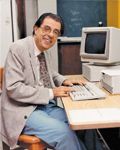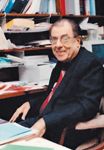Georges Guiochon: Separation Science Innovator
Professor Georges Guiochon spoke to Fabrice Gritti about his pioneering contributions to the field of separation science.
Professor Georges Guiochon spoke to Fabrice Gritti about his pioneering contributions to the field of separation science.
Fabrice Gritti: How did you enter the field of analytical chemistry and come to specialize in gas chromatography (GC)?
Georges Guiochon: After graduating from Ecole Polytechnique in Paris, in 1953 with a Masters degree in engineering, I accepted a graduate student position to research why ammonium nitrate was unstable under certain conditions.

In 1947 ammonium nitrate had been the source of two devastating explosions on cargo ships, one in Texas, USA, and another in Brest, France, that resulted in numerous casualties and widespread devastation.
On 16 April 1947 in Texas, a cargo ship, The Grandcamp, was being loaded with bags of ammonium nitrate fertilizer when a fire was detected in the hold. However, at this point 2600 tonnes of ammonium nitrate were aboard. The captain responded by tightly closing the hold and pumping in pressurized steam. One hour later, the ship exploded, killing several hundred people and setting fire to another vessel, The High Flyer, which was moored 250 metres away and contained 1050 tonnes of sulphur and 960 tonnes of ammonium nitrate. The Grandcamp explosion also created a powerful earthshock that broke windows as far as 40 miles away and knocked two small planes flying at 1500 feet (460 m) out of the sky.
The High Flyer exploded the next day, during the night, after having burned for 16 hours. A store of 500 tonnes of ammonium nitrate in the nearby warehouse also burned, but without exploding, probably because it was less tightly packed. All but one member of the Texas City fire department died. An estimated 567 people died in Texas City and 5000 people were injured; it was the worst industrial disaster in US history.
On 28 July 1947 in Brest, another cargo ship, The Ocean Liberty, was loaded with 3300 tonnes of ammonium nitrate and various inflammable products when it caught fire. The captain also ordered the hold to be sealed while pressurized steam was pumped in. As this did not stop the fire, the vessel was towed out of the harbour at 14:00, and exploded at 17:00. The explosion caused 29 deaths on the quay side and serious damage to the harbour of Brest.
The objective of my research was to determine regulations required for the safe manufacturing, packaging, storage, and transportation of ammonium nitrate, which was growing in demand, particularly for agricultural applications. At around this time my mentor, Professor Leon Jacque, professor at Ecole Polytechnique, received a visitor who wanted research performed into a hypothesized phenomenon. He believed that strong ultrasonic vibrations from the ship hull generated by hoists uploading bags of ammonium nitrate aboard the ship could cause the transmutation of nitrogen into carbon monoxide (which has roughly the same molecular weight: 28).
The mixture of carbon monoxide and air would then result in an explosion. This hypothesis was far-fetched because nitrogen transmutation would require the input of a very large amount of energy. The mass of CO is less than that of N2. It would have been possible for a spontaneous transmutation to occur in the opposite direction.
On realizing that the visitor was the son-in-law of the French Prime Minister at the time, rather than rejecting the idea, my mentor answered that a powerful, highly sensitive analytical instrument would be needed to detect traces of carbon monoxide in air. This exchange took place shortly after the publication of the paper by James and Martin on gas chromatography (GC), when gas chromatographs began to be manufactured.

My mentor requested that the Office of the Prime Minister provide the funds to buy a GC instrument to research the hypothesized phenomenon. The decision was positive, fast, and we rapidly obtained this instrument, even though the purchase of American goods was tightly controlled at that time. Obviously, I did not detect any CO in the decomposition gases of ammonium nitrate, even under high-energy ultrasonic irradiation. This was not important because the French Prime Minister was replaced in the mean time. I soon put the instrument to good use by investigating other fields of interest of my mentor such as the compositions of natural essential oils, gasoline, and other petroleum distillation fractions. From then on I was hooked on GC, from which I was later attracted to high performance liquid chromatography (HPLC) and supercritical fluid chromatography (SFC).
FG: You focused on GC between 1955 and 1984. What do you regard as your main contributions to both the fundamental and practical aspects of GC?
GG: Some interesting work involved the investigation of non-linear GC for the development of methods for the preparative production of butadiene, 2-methylbutadiene, and related olefins for a French company that was producing high-molecular- weight elastomers. The molecular weight obtained by polycondensation of these olefins is limited by the presence of certain impurities (for example, isoprene) that interrupt the polycondensation when they become bonded at the end of a monomeric chain. It was useful for the company to measure the properties of elastomers made with known concentrations of these impurities and to derive the specifications for the reagents needed for the production of different brands of elastomers.

We built several GC preparative instruments using 4-cm, 10-cm, and 30-cm diameter packed columns (one was several metres long) and produced ultra-pure C4, C5, and C6 olefins by the kilogram. This gave me a good empirical understanding of non-linear and preparative GC that was helpful later in doing similar studies in HPLC. These early attempts at producing high-purity compounds by gas chromatography were essentially experimental work as there was little interest in fundamental work at that time in France. It became clear that there were not many valuable compounds with a vapour pressure high enough to permit significant production rates using GC.
FG: After a first successful academic career in France, you decided to go to the US. There, you started a vast research programme in preparative liquid chromatography (Prep LC). What drove you there and why did you want to focus on Prep LC?
GG: An important event in France at this time was the election of Francois Mitterand as President of the Republic in 1981 because this major political shift had unexpected consequences. Before this election, French universities and administrations that supported academic research were supervised by administrators appointed by the government and confirmed by a conservative congress that oversaw non-political distribution of grants.
When Mitterand was elected, and formed the first socialist government, generous spending began on many popular social projects. Credits for academic research were also markedly increased. After a couple of years, the government realized that there was much less money available than they had dreamt and austerity became enforced. Life became much worse in France than in the US universities. As a result, research grants were thinned out, university organization was changed, work became less pleasant, and politics pervaded the academic system. Since I had many friendly colleagues in the USA, I decided to move there.

FG: What has the theory of Prep LC, which you developed over 25 years, brought to the practical challenges met by the industry?
GG: Preparative chromatography is important for a number of reasons, including the role it plays in the production of pure chemicals. Books on preparative chromatography are always in demand, as are other publications that clarify and make it more practical. An annual meeting on preparative scale chromatography (PREP-1985 to PREP-2015) attracts hundreds of participants from industry, government laboratories, and academy. My involvement in preparative-scale chromatography is a source of satisfaction because I observe the field evolve and see the realization of what was once a promising idea. It is especially satisfying to discuss matters with someone who applies preparative chromatography, to reply to questions, and to enjoy recognition in this important area of separation science.
FG: How important is the role of Prep LC in the chemical and pharmaceutical industries at present? How do you think it will evolve in the future?
GG: To meet specifications, many pharmaceuticals and fine chemicals are made from intermediates — chemicals that are extracted or purified by preparative chromatography. Similarly, more and more biopharmaceuticals must be extracted from cells or other organisms involved in their production and be separated from other compounds and viruses that might have adverse effects on patient health.
Various forms of chromatography used for extraction and purification will remain important. There is considerable opportunity for separation scientists to address issues in the biotechnology area, specifically in the separation of biochemicals.
FG: Supercritical fluid chromatography (SFC) analysis and Prep SFC have grown up over the last few years. You have recently engaged yourself in bridging the gap between Prep GC and Prep HPLC. Could you comment on the future benefits of SFC and Prep SFC?
GG: Although it is more complex, preparative SFC is an attractive alternative to preparative HPLC. The main reason for industry interest is because of the fast rate of mass transfers in SFC columns and the low viscosity of the eluents used for SFC separations. Columns used in SFC have as high an efficiency as those used in HPLC, but should be operated at a flow rate that is several times higher. As a result, SFC analysis is much faster, more productive, with higher analytical throughput. Because of its complexity, developing SFC separations requires the attention of engineers and technicians who are well-educated in the fundamentals of chromatography. One specific area where SFC overtakes GC and HPLC is the purification of large amounts of pure enantiomers.
FG: During your whole career you have been very active at the interface between the academic and the industrial world. What do you think will be the next challenges for the future generation of analytical chemists?
GG: It was fun to be in this position because it was where the action was, at the border between several important domains. My education background — a Master's degree in chemical engineering and a PhD in physical chemistry — combined with intense research in analytical GC helped me in finding critical problems, formulating them, and developing solutions.
Chromatography involves a wide range of physical chemistry areas: Adsorption and solvation equilibria, mass transfer kinetics, hydrodynamics, the consolidation of beds of particles, spectrophotometric, and other detection methods. Success requires an advanced knowledge in multiple fields. Future chromatographers will have to build on past achievements and develop powerful, useful methods. As in all areas of science and technology, separation science may suffer slowdowns with progress limited by a lack of funding. At this point it remains lively and demanding.
FG: Are there any specific separation scientists that have inspired you? If so, how?
GG: Geza Schay and Istvan Halasz taught me chromatography. Keulemans introduced me to A.J.P. Martin, to Janak, and to many Eastern European colleagues. Attending many meetings across the world, I met Ernst Bayer, Ervin Kovats, Cartony Phillips, Dennis Desty, Marcel Golay, John Calvin Giddings, Csaba Horvath, Josef Huber, Roy Keller, John Knox, A. Zlatkis, J.J. van Deemter, J.H. Purnell, and so many others who came to be famous in the 1950s to 1980s. Whether these individuals remain famous or not is unimportant. The contributions of these scientists and others who were involved in chromatography since Tswett will remain important in the future because we all build on previous knowledge even if we don't know the source.
I was lucky to find a scientific domain that involved so many different branches of science and technology at a period where its understanding and expansion was critical for a wide range of practical applications and where many important new problems had to be identified and solved. I was happy to meet many fine people who helped me to contribute to this task and who supported me.
FG: You were involved in the early days of computing in chromatography. Could you elaborate on your early work, how the field has evolved and where it is going?
GG: I moved to Knoxville (Tennessee, USA) at the time when minicomputers, desktop computers (and later laptop computers) were becoming available and affordable. At the same time, useful programs were available that allowed the storage and interpretation of data using appropriate models. There were excellent theories of non-linear chromatography that had not been used because of insufficient computational power. Suddenly, this power appeared, within a few years I was ready and began to make intensive use of computers in preparative and non-linear chromatography.
FG: What do you regard as the unexplored avenues of chromatography?
GG: I feel that the most important areas of pure chromatography that have not been sufficiently explored are multidimensional chromatography combined with various detection techniques, and the preparation of efficient chromatographic beds.
Over the last 40 years the efficiency of columns has markedly improved. Column efficiency can be conveniently expressed as the HETP, H = h dp, where dp is the average size of the particles used to pack the columns. Forty years ago, dp was about 20 µm; now it is 1.6 µm to 2.6 µm depending on the column length that we can afford. h used to be 4 to 5 in the mid 1970s before it decreased to 2.0–2.3 in the late 1990s. Now it has dropped to 1.5–1.8. On theoretical grounds, we anticipate a possible minimum around 0.9. This could provide great progress but it is still uncertain how to do it and this will require considerable improvements in the instruments used to operate the columns.
The applications of chromatography to the extraction and purification of biochemicals raise important difficulties. Many biochemicals found in nature are mixtures of conformers that are difficult to separate and to identify. The systematic use of high performance liquid chromatography coupled with nuclear magnetic resonance spectrscopy (HPLC–NMR) could potentially provide a useful method of approach. This tool is not yet widespread in academic laboratories.but promises great rewards. Another interesting areas is miniaturization that may lead to advances in medical and forensic testing. All these promising areas add to the vibrancy of the separation science field.

University of Rouen-Normandy Scientists Explore Eco-Friendly Sampling Approach for GC-HRMS
April 17th 2025Root exudates—substances secreted by living plant roots—are challenging to sample, as they are typically extracted using artificial devices and can vary widely in both quantity and composition across plant species.
Sorbonne Researchers Develop Miniaturized GC Detector for VOC Analysis
April 16th 2025A team of scientists from the Paris university developed and optimized MAVERIC, a miniaturized and autonomous gas chromatography (GC) system coupled to a nano-gravimetric detector (NGD) based on a NEMS (nano-electromechanical-system) resonator.












